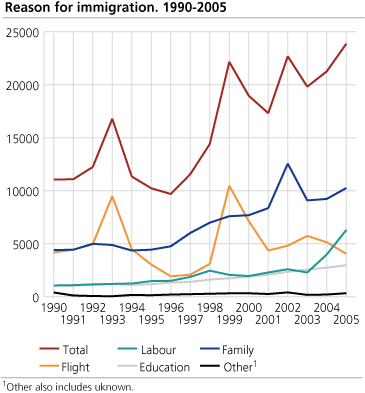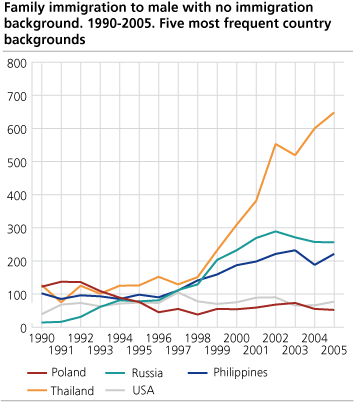Content
Published:
This is an archived release.
Family immigration is most common
254 000 first-generation immigrants with non-Nordic citizenship immigrated to Norway between 1990 and 2005, and 7 out of 10 still live here. Most of the immigrants came due to family reunion or flight.
Statistics about reason for immigration deal with all first-generation immigrants with non-Nordic citizenship that immigrated to Norway between 1990 and 2005.
If we look at the period between 1990 and 2005, more than 254 000 people with non-Nordic citizenship immigrated to Norway. About 110 000 (43 percent) immigrated as family immigrants. Approximately one third have arrived as refugees (31 percent), while 14 percent immigrated due to labour. 11 percent got permission for education and immigrated for this reason between 1990 and 2005.
More women than men
The majority of the people that immigrated to Norway between 1990 and 2005 were women. There were however differences between the sexes when it came to reason for immigration. Most men immigrated as refugees (38 percent), family immigrants (31 percent) and labour (21 percent). Most women immigrated to Norway as family immigrants (55 percent). There where almost twice as many women (72 000) as men (38 000) that immigrated to their family between 1990 and 2005. Women made a relatively low share of the people who immigrated due to labour with 25 %.
Many young people immigrated to Norway between 1990 and 2005. About 2/3 were younger than 30 years old and as much as 9 out of 10 where younger than 40 years old. There were also differences in the age structure between the different groups related to the reason for immigration. The age structure among the people that immigrated as refugees or family immigrants was most scattered, and the reason for this is that there are many children among these. Those who immigrated due to labour were strongly represented in the age group between 20 and 39 years old. 78 percent of all people that immigrated due to labour were under 40 years old.
The number of family reunions increases
There has been a distinguished increase in the number of family immigrations between 1990 and 2005. Citizens from Thailand, Iraq and Pakistan are the largest groups among the family immigrated, with more than 6000 reunions in the period. Russia, Somalia, USA, Great Britain and Turkey had more than 5000 reunions.
|
Familyimmigrations,
by citizenship. 1990-2005 |
| Thailand | 6 754 | ||||||||||||||||||||||||||||||||||||||
|---|---|---|---|---|---|---|---|---|---|---|---|---|---|---|---|---|---|---|---|---|---|---|---|---|---|---|---|---|---|---|---|---|---|---|---|---|---|---|---|
| Iraq | 6 706 | ||||||||||||||||||||||||||||||||||||||
| Pakistan | 6 185 | ||||||||||||||||||||||||||||||||||||||
| Russia | 5 584 | ||||||||||||||||||||||||||||||||||||||
| Somalia | 5 561 | ||||||||||||||||||||||||||||||||||||||
| USA | 5 310 | ||||||||||||||||||||||||||||||||||||||
| Turkey | 5 150 | ||||||||||||||||||||||||||||||||||||||
| United Kingdom | 4 574 | ||||||||||||||||||||||||||||||||||||||
| Philippines | 3 992 | ||||||||||||||||||||||||||||||||||||||
There are many women from non-western countries, like Thailand, Russia and Philippines, among the immigrants who family immigrate to a man with Norwegian country background. Men from USA and Great Britain dominate among the immigrants who family immigrate to a woman with Norwegian country background. Norwegian country background means that the person has at least one Norwegian parent.
There have been a significant number of family immigrations from Pakistan, Iraq, Turkey and Sri Lanka where both people had the same country background.
|
Family immigrations to
male with Norwegian country background. 1990-2005. Ten most frequent countries |
| Thailand | 4 353 | ||||||||||||||||||||||||||||||||||||||
|---|---|---|---|---|---|---|---|---|---|---|---|---|---|---|---|---|---|---|---|---|---|---|---|---|---|---|---|---|---|---|---|---|---|---|---|---|---|---|---|
| Russia | 2 380 | ||||||||||||||||||||||||||||||||||||||
| Philippines | 2 307 | ||||||||||||||||||||||||||||||||||||||
| Poland | 1 223 | ||||||||||||||||||||||||||||||||||||||
| USA | 1 176 | ||||||||||||||||||||||||||||||||||||||
| Brazil | 662 | ||||||||||||||||||||||||||||||||||||||
| United Kingdom | 438 | ||||||||||||||||||||||||||||||||||||||
| Germany | 436 | ||||||||||||||||||||||||||||||||||||||
| Romania | 433 | ||||||||||||||||||||||||||||||||||||||
| Ukraina | 414 | ||||||||||||||||||||||||||||||||||||||
|
Family immigration to
spouse/registered partner with the same country background. 1990-2005. Ten most frequent countries |
| Pakistan | 3 920 | ||||||||||||||||||||||||||||||||||||||
|---|---|---|---|---|---|---|---|---|---|---|---|---|---|---|---|---|---|---|---|---|---|---|---|---|---|---|---|---|---|---|---|---|---|---|---|---|---|---|---|
| Iraq | 2 538 | ||||||||||||||||||||||||||||||||||||||
| Turkey | 2 407 | ||||||||||||||||||||||||||||||||||||||
| Sri Lanka | 2 202 | ||||||||||||||||||||||||||||||||||||||
| Vietnam | 1 825 | ||||||||||||||||||||||||||||||||||||||
| Somalia | 1 528 | ||||||||||||||||||||||||||||||||||||||
| Iran | 1 386 | ||||||||||||||||||||||||||||||||||||||
| India | 1 070 | ||||||||||||||||||||||||||||||||||||||
| United Kingdom | 1 020 | ||||||||||||||||||||||||||||||||||||||
| Marocco | 1 012 | ||||||||||||||||||||||||||||||||||||||
One third immigrated due to flight
The effects of the Balkan conflicts are obvious when we look at people who immigrated to Norway as refugees (family immigrants are not included). 1993 and 1999 were the peak years, and this was mainly due to immigration from Bosnia-Herzegovina in 1993-1994 and Serbia (mainly Albanians from Kosovo) in 1999. The reason for the rise in immigrations due to flight after the year 2000 was mainly because of immigrations from Iraq, Somalia, Afghanistan and Russia (Chechens).
|
Persons with flight as
reason for immigration. 1990-2005. Ten most frequent country backgrounds |
| Serbia and Montengero | 14 035 | ||||||||||||||||||||||||||||||||||||||
|---|---|---|---|---|---|---|---|---|---|---|---|---|---|---|---|---|---|---|---|---|---|---|---|---|---|---|---|---|---|---|---|---|---|---|---|---|---|---|---|
| Bosnia-Herzegovina | 13 155 | ||||||||||||||||||||||||||||||||||||||
| Iraq | 10 791 | ||||||||||||||||||||||||||||||||||||||
| Somalia | 8 941 | ||||||||||||||||||||||||||||||||||||||
| Iran | 5 823 | ||||||||||||||||||||||||||||||||||||||
| Afghanistan | 4 052 | ||||||||||||||||||||||||||||||||||||||
| Russia | 3 293 | ||||||||||||||||||||||||||||||||||||||
| Vietnam | 2 227 | ||||||||||||||||||||||||||||||||||||||
| Sri Lanka | 1 713 | ||||||||||||||||||||||||||||||||||||||
| Etiopia | 1 641 | ||||||||||||||||||||||||||||||||||||||
2/3 of those who immigrates due to labour come from western countries
34 000 people immigrated to Norway due to labour between 1990 and 2005. As much as 27 000 (79 percent) came from a European country. Most of these immigrants came from Great Britain, Germany and Poland. The immigration due to labour from Poland and Lithuania has grown significantly the last 2-3 years.
|
Immigrants with labour
as reason for immigration. 1990-2005. Ten most frequent country backgrounds |
| United Kingdom | 5 959 | ||||||||||||||||||||||||||||||||||||||
|---|---|---|---|---|---|---|---|---|---|---|---|---|---|---|---|---|---|---|---|---|---|---|---|---|---|---|---|---|---|---|---|---|---|---|---|---|---|---|---|
| Germany | 5 802 | ||||||||||||||||||||||||||||||||||||||
| Poland | 4 397 | ||||||||||||||||||||||||||||||||||||||
| USA | 2 981 | ||||||||||||||||||||||||||||||||||||||
| France | 2 051 | ||||||||||||||||||||||||||||||||||||||
| Netherlands | 2 041 | ||||||||||||||||||||||||||||||||||||||
| Lithuania | 936 | ||||||||||||||||||||||||||||||||||||||
| Italy | 823 | ||||||||||||||||||||||||||||||||||||||
| Russia | 788 | ||||||||||||||||||||||||||||||||||||||
| Spain | 532 | ||||||||||||||||||||||||||||||||||||||
More people immigrate for education
11 percent of the people that immigrated between 1990 and 2005 did so because of education. There were relatively many immigrants from Germany, China, Russia and USA in this group. If we consider the whole period, the number of western students has been stable, while the number of students from non-western countries has risen constantly. 70 percent of those who immigrated for education in the period came from non-western countries. The rise in the number of immigrations for non-western students was especially significant in the last five years. There has been a noticeable rise in the number of immigrations for education, especially from China, Russia, the Philippines and Poland.
|
Persons with education
as reason for immigration. 1990-2005. Ten most frequent country backgrounds |
| Germany | 2 427 | ||||||||||||||||||||||||||||||||||||||
|---|---|---|---|---|---|---|---|---|---|---|---|---|---|---|---|---|---|---|---|---|---|---|---|---|---|---|---|---|---|---|---|---|---|---|---|---|---|---|---|
| China | 1 885 | ||||||||||||||||||||||||||||||||||||||
| Russia | 1 654 | ||||||||||||||||||||||||||||||||||||||
| USA | 1 551 | ||||||||||||||||||||||||||||||||||||||
| Philippines | 1 450 | ||||||||||||||||||||||||||||||||||||||
| Poland | 1 013 | ||||||||||||||||||||||||||||||||||||||
| Lithuania | 803 | ||||||||||||||||||||||||||||||||||||||
| Ghana | 768 | ||||||||||||||||||||||||||||||||||||||
| Latvia | 676 | ||||||||||||||||||||||||||||||||||||||
| Romania | 633 | ||||||||||||||||||||||||||||||||||||||
Everybody doesn’t stay in the country
Everyone who immigrates to Norway does not stay here for the rest of their lives. More than 254 000 people immigrated to Norway between 1990 and 2005, and 72 percent (184 000) still lived in the country in the beginning of 2006. The reason for immigration is significant for to what degree they leave the country. Among those who immigrated for education, only 37 percent still lived here on the 1. January 2006. As much as 82 percent of those who immigrated for this reason before year 2000 have left the country. 7 out of 10 of those who immigrated for labour before the year 2000 have also left the country. More than 80 percent of the refugees and family immigrants still live here by the 1. January 2006.
Tables:
- Table 1 First-time immigrations among first generation immigrants with non-Nordic citizenship, by reason for immigration and year of immigration
- Table 2 First-time immigrations among first generation immigrants with non-Nordic citizenship, by reason for immigration, year of immigration and first citizenship. Western and non-western citizenship
- Table 3 First-time immigrations among first generation immigrants with non-Nordic citizenship, by first citizenship and reason for immigration. 1990-2005
- Table 4 First-time immigrations among first generation immigrants with non-Nordic citizenship, by reason for immigration, sex and age. Year of immigration 1990-2005
- Table 5 First-time immigrations among first generation immigrants with non-Nordic citizenship, by reason for immigration and status. 1990-2005
Contact
-
Statistics Norway's Information Centre
E-mail: informasjon@ssb.no
tel.: (+47) 21 09 46 42
-
Oppdrag innvandring
E-mail: oppdraginnvandring@ssb.no
-
Mads Ivar Kirkeberg
E-mail: mads.ivar.kirkeberg@ssb.no
tel.: (+47) 40 81 13 21
-
Frøydis Strøm
E-mail: froydis.strom@ssb.no
tel.: (+47) 40 81 13 17


